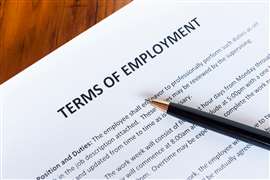Read this article in Français Deutsch Italiano Português Español
U.S. noncompete ban: protecting company interests if or when it goes through
06 May 2024
The rule banning noncompete agreements is already facing legal challenges. In the meantime, companies can take steps to protect their interests.
Power Progress recently reported that the U.S. Federal Trade Commission (FTC) established a final rule banning noncompete agreements. In the press release announcing the final rule, the FTC said that “an estimated 30 million workers — nearly one in five Americans — are subject to a noncompete.”
However, the rule is already facing legal challenges. CNN reported the U.S. Chamber of Commerce and the Business Roundtable filed a lawsuit in Texas, as did business tax services firm Ryan.
“Both of which challenged the FTC ruling on several bases,” said Jared Speier, a partner in the employment law practice at business law firm Stradling. “That they don’t have the authority to do it. That it violates the Constitution. And they both asked for an injunction.”
While the FTC said the rule will become effective 120 days after publication in the Federal Register, Speier said legal challenges such as these could mean “it’s going to be even longer before we see this actually come into effect.”
While manufacturers wait for a resolution, there are steps that they can take to protect themselves and their interests.
Review Employment Restrictions
In its press release, the FTC said existing noncompete agreements would be unenforceable under the new rule except for those that apply to senior executives, who are defined in the rule as workers earning more than $151,164 per year and who make policy decisions for the organization.
 Photo: Alamy
Photo: Alamy
Matthew Fontana, a partner at the law firm of Faegre Drinker Biddle & Reath with expertise in labor and employment law, said now is the time for a company to review existing employment restrictions.
“What are they, who do you give them to, what is the reason and rationale for them, what’s the interest that the employer is seeking to protect?” he said.
Fontana said that while there is not a one-size-fits all approach to addressing the rule, he recommended manufacturers contact their legal counsel so any employment restrictions they have in place for certain personnel can be reviewed to determine if the rule, should it go forward, will have an impact.
“And based on that advice, make some decisions about how you best want to protect the interests that you’re wanting to protect,” he said.
Intellectual Property Protections
One such affected interest is trade secrets. To address that, Speier said companies should take this time to focus on the confidentiality and trade secret agreements they have with their employees.
“Because if this noncompete ban goes into effect, that’s going to be your shield,” he said. “Having strong confidentiality agreements, protecting all of your trade secret information, your business plans, your customer information and all that stuff.”
The FTC said in its announcement that more than 95 percent of workers with a noncompete agreement have also signed a nondisclosure agreement.
Speier said some of his clients are currently shoring up their existing employment agreements with senior executives.
 Photo: Alamy
Photo: Alamy
“At least for your hires within the next three or four months and current senior executives you have, it’s probably worthwhile to look into making sure you have strong noncompetition agreements with them in the event that this rule goes forward,” he said.
Bill Honaker with the Dickinson Wright law firm has 40 years of experience practicing law related to patents, trademarks, copyrights and trade secrets. He said there are other laws specifically intended to protect trade secrets.
“Being able to prevent, let’s say, your head of innovation from leaving the company and going to work for a competitor — [they are] another way of protecting that,” he said. “That trade secret area, that intellectual property area.”
According to Honaker, companies should ensure they have strong trade secret language in their existing employment agreements.
“You don’t want to list out your trade secrets, but you want an indication in there that the employee is going to have access to trade secrets and you don’t want those trade secrets leaving,” he said.
Speier added that some states have inevitable disclosure rules, which according to the Boston (Mass.) Bar Association website addresses situations in which there’s enough overlap between an employee’s new job and their previous one that it’s inevitable the employee will disclose confidential information from their previous employer. Courts could then prevent such an employee from working for a competitive company.
Inevitable disclosure rules can help companies enforce trade secret agreements, Speier said, but it’s important to understand if your state has such rules.
“For instance, California is not an inevitable disclosure state. So, enforcing trade secret and confidentiality agreements in California is harder.”
Implement Strong Processes
Honaker offered additional advice regarding how to protect trade secrets within an organization.
“What I find effective is when an employee leaves to remind the employee and show them their agreement where they agree not to take trade secrets with them,” he said, “and to be able to send their new employer a copy of that agreement and indicate that they have agreed to this, and we don’t want you or them using our trade secrets.”
Other best practices include ensuring proper systems are in place to minimize employee access to sensitive information after an employee leaves.
“Issue company phones, issue company computers, make sure you have the proper systems in place to lock those down when an employee leaves so they’re not leaving with your technology — your trade secrets — in their hand,” he said. “I’ve got a case right now where that’s happened.”
Honaker also advises companies to limit access to sensitive information.
“With regard to [a company’s] internal policies, review those policies and make sure that access to confidential trade secret information is limited and is cut off as soon as employee leaves leaves the company so they can’t come back and get their information.”
Finally, Honaker said organizations should remain vigilant about existing employees potentially misusing their access to sensitive data. He said there are indicators that an employee might be stealing company secrets.
“If you start having a lot of data leaving your company, find out why,” he said. “There have been situations where, for example, a few years ago, Tesla had an employee who all of a sudden got a red flag because a lot of data was being extracted and he was taking Tesla trade secrets.”
POWER SOURCING GUIDE
The trusted reference and buyer’s guide for 83 years
The original “desktop search engine,” guiding nearly 10,000 users in more than 90 countries it is the primary reference for specifications and details on all the components that go into engine systems.
Visit Now
STAY CONNECTED




Receive the information you need when you need it through our world-leading magazines, newsletters and daily briefings.
CONNECT WITH THE TEAM













